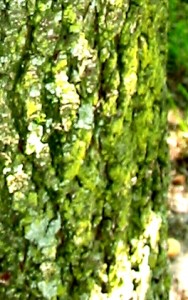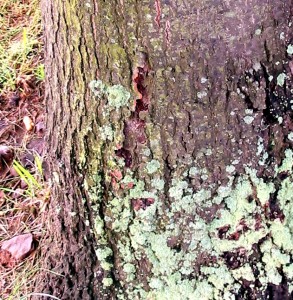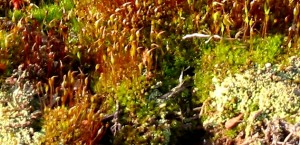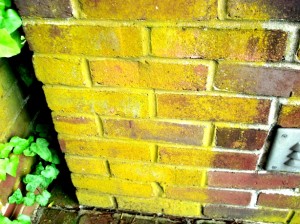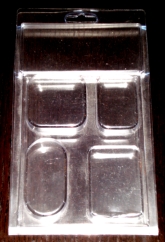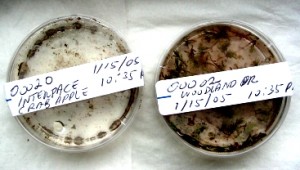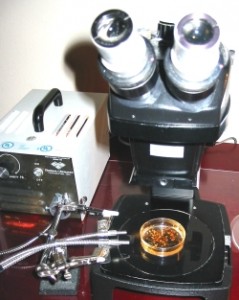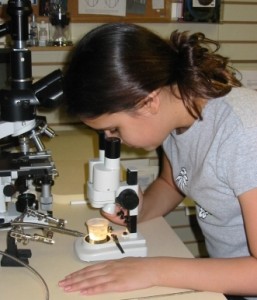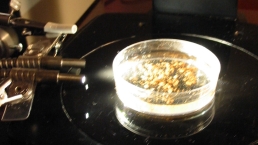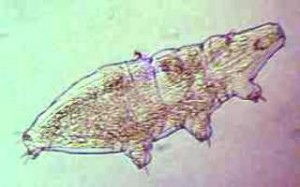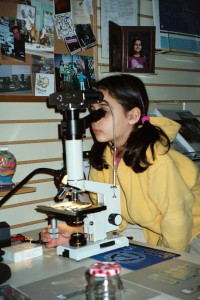Tardigrades are microscopic creatures that are a maximum of one millimeter in size, but usually are found to be about half that size. These are little creatures that live in moist lichen, moss, or leaf litter.
They are harmless, and cute. Yes cute. They are often referred to as “Water Bears” because they look like little bears with eight puffy legs, and they have claws that look like those a grizzly bear would have. In fact, they have two eyes, a nose and a mouth, kind of like a bear. So how do you find them, how long do they live, what climates do they live in? Those are some often asked questions.
They can live a hundred years, withstand extreme heat and cold, and you find them everywhere. They protect themselves by going into a type of hibernation called cryptobiosis. They roll up into a dried little ball, and just stay dormant, with no sign of life whatsoever. Scientists have rehydrated them from a piece of moss in a museum collection that was a hundred years old. They’ve been frozen and defrosted, put under pressure, subjected to very high temperatures, and zapped with X-Rays. They come out alive and well. Just add water.
They have recently been sent into space. See the YouTube video here.
The easiest place to start is to find some moist lichen, that the yellow fuzzy stuff on a tree in your yard. Lichen grows on the shady side of the tree. Picture below left.
Scrape some lichen into a paper bag, an ordinary lunch bag, or perhaps an envelope. Don’t use plastic bags, because the moisture in there will allow mold to grow, and looking at mold is a different science project!
The best lichen to collect is not that hard crusty kind, shown in the bottom picture. Sometimes the lichen is greenish yellow, the softer, the better. See the picture on right. This lichen is fairly good. It is greenish yellow and soft.
Begin by finding a good tree with soft fluff that grows on the dark side of the tree. Besides trees, you can also find tardigrades in moss. Go for the soft young moss. In the below picture, you can see moss in all of its stages of growth, and even some lichen growing with it. Tardigrades like to hide in fluff, so that’s what to look for. Simply pull up some clumps of moss and put it in a paper bag.
Again, use paper bags, not plastic bags, when collecting moss and lichen, because that allows air to dry out what you have collected. You do not want mold to grow on your moss or lichen, and that’s what will happen in a plastic bag that is air tight. So always use paper bags, the kind you get to pack lunch sandwiches in.
You might even find some lichen on a rock or a brick wall, as shown in this picture. It’s fine. Tardigrades are sure to be in this lichen.
Next, you will need a clear plastic Petri dish, or something like it. You could use a clear plastic container, like the lid from a food container, the top of a little plastic box for cosmetics, a piece of cut of blister packaging that hangs on the rack in the store.
Most small products are blister packed, that is packaged in a hard plastic shell backed by the color cardboard product description. Cut out a piece of plastic that will hold about a half inch of water, like a little bowl or water for a hamster. The “dish,” as we will call it, does not have to be round.
Sprinkle some lichen into it, just a tiny pinch. Remember, this is a microscopic journey, so a pinch is a ton of material under the microscope. Then add some bottled water, again, just about half in inch. Set aside, and let the lichen soak over night. Ideally, you could use plastic Petri dishes, as you can cover these to prevent dust and mold spores from getting into the water. In the picture here, you can see that I have set up two Petri dishes, one with moss and one with lichen. When you add the water and let it sit, it is called a “suspension.”
You will need a microscope. A dissecting microscope is best, but there are some very good amateur microscopes available at reasonable prices. Sometimes called a binocular stereo scope, it will open up a whole new world to you. Here is the one I use, which I purchased second hand for under $100.00 on eBay. This is a very high quality Bausch & Lomb dissecting microscope, however you don’t need anything so fancy.
Dissecting Microscope with fiber optic illuminator and cable on left. Tardigrade suspension on the base.
Nowadays, you get fairly good optical quality for your money spent. The nice thing is that you do not need high power to see and observe tardigrades.
Your lowest magnification will be perfect, as only 15 to 30 times magnification is all you need to find a tardigrade.
In fact, higher powers make it more difficult to search through the jungle of lichen you have created. When ready to examine the specimen under the microscope you need to place a piece of black paper under your clear dish or container. Place that on the microscope stage. In the below picture, you see a Petri dish with light from the side. Somehow, you will have to mount or set up a narrow beam of light, from a flashlight or even a high intensity desk lamp. Shoot the beam across the bottom of specimen dish.
In other words, you do not illuminate the lichen from underneath, like you would if you were examining a glass microscope slide. No. You will have to illuminate the lichen suspension from the side. A horizontal beam makes any tardigrades or other creatures now appearing in your specimen dish glow white, and they will stand out clearly.
Now you have to focus the microscope, at lowest power, on the debris that rests on the bottom of the dish. If you try to use a higher power objective lens, you will wind up with it under water. You do not want that to happen, or you will ruin the optics. So, use the lowest power objective, and that will give you what’s called a good working distance, or separation from the surface of the water.
Once you have focused on the bottom of the dish, and the light is streaming sideways across brightly illuminating the lichen, you can methodically examine the specimen. You are hunting for bears. These are slow moving creatures, which is why they have been named tardigrades, or slow-walkers. What does a tardigrade look like?
If you Google search, you will see many examples. Your Google search would probably lead you to my website with loads of pictures showing the various types of tardigrades found in my New Jersey Tardigrade Survey: www.tardigrade.us
Looking in your Petri dish, don’t be discouraged if you don’t find any at first. Sometimes, they can take two or three days to emerge from their hibernation. Sometimes you have to look in another sample of lichen or in a sample of moss or lichen. Eventually, you will find one.
There is a saying that the first tardigrade you ever find is the hardest to find. Good hunting.
Happy Hunting!
Mike Shaw
All
comments
to the author Mike Shaw are welcomed.
Minor revision Sept. 8th 2015 correcting the number of legs.
Microscopy
UK
Front Page
Micscape Magazine
Article Library
© Microscopy UK or their contributors.
Published in the
October 2011 edition of Micscape.
Please report any Web problems or
offer general comments to the Micscape
Editor.
Micscape is the on-line monthly magazine
of the Microscopy UK web
site at Microscopy-UK
© Onview.net Ltd, Microscopy-UK, and all contributors 1995 onwards. All rights reserved. Main site is at www.microscopy-uk.org.uk.

